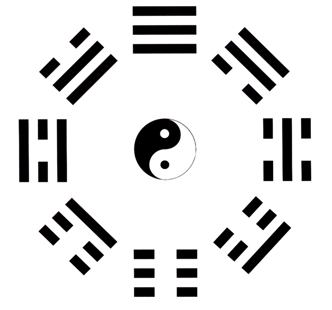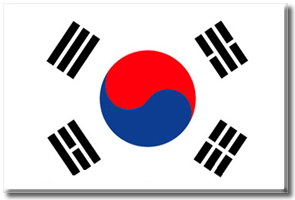[ English Summary ]
Nel Taekwon-Do la bandiera coreana (e precisamente quella della Corea del Sud) assume un particolare significato. Essa infatti, piú di altre bandiere nazionali, è ricca di significati filosofici richiamati nell’arte e nelle sue forme (Poomsae). Considerando i presupposti che sottostanno alla sua origine gli stessi coreani amano definire il simbolo della loro nazione come “la bandiera dei grandi opposti“.
Le origini della sua ricca simbologia vanno ricercate nella filosofia dell’Eum Yang (piú nota in lingua cinese come Yin e Yang). Yin e Yang stanno a indicare le due forze metafisiche supreme, opposte e complementari l’una all’altra, e che determinano, con il loro alternarsi ciclico, l’origine dell’universo e l’equilibrio vitale. Il tempo viene concepito come una realtà segnata dal mutamento di ogni cosa nel suo opposto, rendendo visibile la presenza dello Yang, energia maschile, luminosa e attiva e dello Yin, energia femminile, oscura e passiva.
Lo Yin è bianco e rappresenta l’energia potenziale, lo Yang è nero e rappresenta il movimento. Il simbolo di cui sopra raffigura il loro rapporto dinamico e inversamente proporzionale: lo Yin raggiunge il suo culmine dove lo Yang finisce e viceversa. Il punto bianco nella parte nera e quello nero nella parte bianca indicano la loro origine l’uno dall’altro e il fatto che essi non possono esistere separatamente.
Nella bandiera coreana lo Yin e lo Yang sono rappresentati dal cerchio centrale rosso e blu che in coreano viene chiamato Taegeuk, nome attribuito spesso alla bandiera stessa. Essa è costituita da tre parti principali:
1) Lo sfondo bianco che simboleggia la pace.
2) Il cerchio blu e rosso, il Taegeuk, che rappresenta il contrasto e l’armonia universale sulla base dei concetti di Eum (il blu) e Yang (il rosso).
3) I quattro trigrammi (in coreano Kwen), ai lati del cerchio, che rappresentano i quattro elementi che costituiscono l’universo: in alto a sinistra il cielo, in alto a destra l’acqua, in basso a sinistra il fuoco, infine in basso a destra la terra.
I quattro trigrammi descrivono elementi in opposizione ma anche in equilibrio tra di loro e la loro stessa disposizione sottolinea questo concetto.

The Taegeuk
English Summary
[ Italian Text ]
In Taekwon-Do the Korean flag (South Korean flag) takes on a particular meaning. It is in fact, more so than other national flags, rich in philosophical meaning reflected in the art of Taekwon-Do and its forms (Poomsae). Considering the basis of the flag’s origins, Koreans define the symbol of their nation like “the flag of great opposites”.
The origins of the flag’s rich symbolism can be traced in the philosophy of Eum Yang (also known as Yin and Yang in Chinese). Yin and Yang represent two supreme metaphysical powers, opposing and complementing the other, that determine, with their cyclical alternation, the origins of the universe and vital energy. The time is conceptualised as a reality marked by the mutation of things into their opposite, enabling the presence of Yang to become visible - male energy, luminous and active - and the presence of Yin - female energy, dark and passive.
Yin is white in colour and represents potential energy, Yang is black in colour and represents movement. The symbol portrays their dynamic relationship in inverse proportion: Yin reaches its apex where Yang finishes, and vice versa. The white dot in the black part and the black dot in the white part of the flag indicate their origins as rising from the other, and the fact that neither can exist without the other.
In the Korean flag the Yin and Yang are represented by the central red and blue circle known in Korean as Taegeuk, a term often used to refer to the Korean flag itself. The flag is comprised of three principle sections:
1) The white background which represents peace.
2) The blue and red circle, the Taegeuk, that represents the contrast and the universal harmony on the base of the concepts of Eum (the blue) and Yang (the red).
3) The four trigrams (in Korean Kwen), to the sides of the circle, that represent the four elements that constitute the universe: aloft to the left the sky, aloft to the right the water, in low to the left the fire, finally in low to the right the earth.
The four trigrams describe elements in opposition but also in equilibrium and they same disposition underlines this concept.


